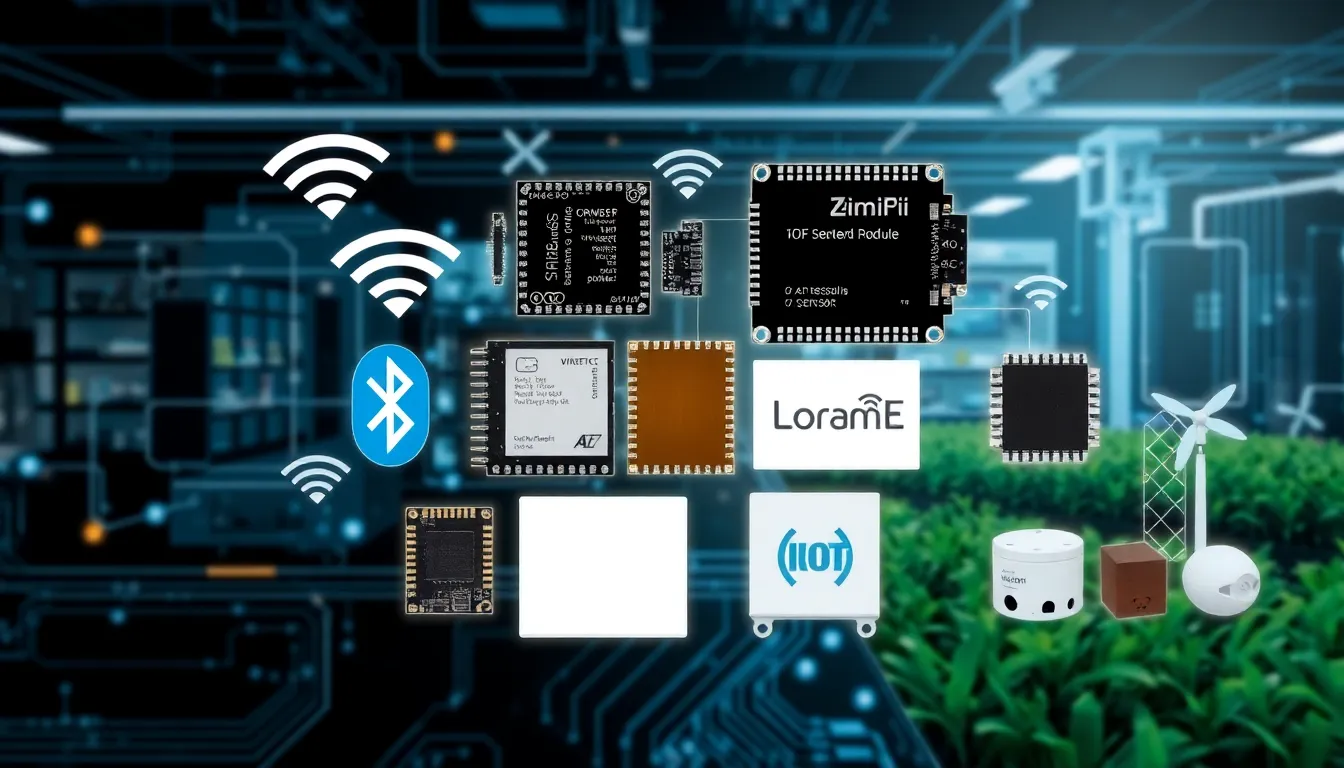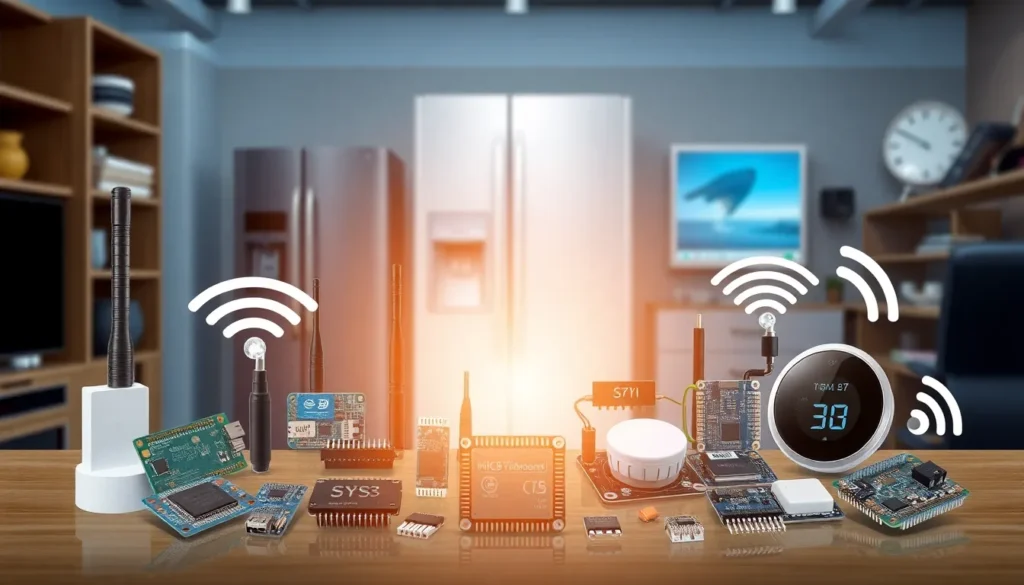Table of Contents
ToggleIn a world where your fridge could remind you to buy milk and your thermostat knows just how cozy you like it, the Internet of Things (IoT) is no longer just a sci-fi fantasy. It’s a reality, and at the heart of this smart revolution are wireless modules. These tiny tech wonders are the unsung heroes that connect everyday devices to the internet, making life easier and a bit more entertaining.
Overview of Internet of Things Wireless Modules
Internet of Things (IoT) wireless modules serve as the backbone of smart device connectivity. They facilitate communication between various gadgets and the internet, empowering users with enhanced functionality.
Definition and Importance
IoT wireless modules refer to compact hardware components that enable devices to connect to networks. These modules play a vital role in modern technology, making real-time data transmission possible. They enhance user experiences by allowing seamless interaction with devices, ensuring convenience. Security features also protect data integrity, vital for user trust. On a broader scale, these modules drive innovation across industries, from healthcare to industrial automation.
Key Components
Several key components make up IoT wireless modules. Antennas transmit and receive radio signals, ensuring reliable communication. Microcontrollers process data, enabling devices to perform specific tasks based on user input. Communication protocols, such as Wi-Fi and Bluetooth, define how devices exchange information. Power management systems optimize energy consumption, prolonging battery life. Lastly, sensors collect real-time data, providing essential insights for smart operations.
Types of Wireless Modules

Various wireless modules play critical roles in the IoT ecosystem. Each type offers unique advantages tailored to specific application needs.
Wi-Fi Modules
Wi-Fi modules support high-speed internet connectivity in IoT devices. Many smart home appliances, such as security cameras and smart speakers, utilize these modules. Wi-Fi modules provide robust data transfer rates, making them suitable for applications requiring substantial bandwidth. They often integrate with existing Wi-Fi networks, enabling seamless connectivity. Popular Wi-Fi modules like ESP8266 and ESP32 offer developers flexibility and ease of use in project implementation.
Bluetooth Modules
Bluetooth modules deliver short-range wireless communication across devices. Devices like wearables, remote controls, and audio systems often deploy these modules. Data exchange occurs quickly, and the technology allows for low power consumption, which extends battery life. Bluetooth Low Energy (BLE) serves many applications, from fitness trackers to smart home systems. Notable Bluetooth modules include HC-05 and HM-10, known for their reliability and simplicity.
Zigbee Modules
Zigbee modules excel in low-power, low-data-rate applications. Smart home devices, including light bulbs and sensors, frequently incorporate these modules. Zigbee’s mesh networking capability enhances communication range and device scalability. Multiple devices can connect without overwhelming the network, making it ideal for home automation. Popular Zigbee modules like XBee and CC2530 provide robust performance and ease of integration for developers.
LoRa Modules
LoRa modules facilitate long-range communication with minimal power usage. They serve rural or expansive applications, such as agricultural monitoring and smart city infrastructure. The technology empowers devices to connect over several kilometers, which traditional protocols may not support. LoRa operates in unlicensed frequency bands, allowing for cost-efficient implementation. Examples such as the LoRaWAN module enable scalable IoT solutions across various sectors.
Applications of Internet of Things Wireless Modules
Internet of Things wireless modules play significant roles in various applications. They enhance functionality and streamline processes in multiple sectors.
Smart Home Devices
Smart home devices utilize wireless modules to create connected environments. Wi-Fi modules enable high-speed streaming for smart TVs and security cameras. Bluetooth modules allow quick communication between wearables and smartphones. Zigbee modules excel in energy efficiency, supporting smart lighting and thermostats. These modules facilitate seamless control through mobile applications, ensuring user convenience. Integration of voice assistants further amplifies this connectivity, leading to personalized experiences. The continuous evolution of these technologies enhances daily living comfort and security.
Industrial Automation
Industrial automation extensively employs wireless modules to optimize operations. Wi-Fi and LoRa modules support data collection from remote machinery, enabling real-time monitoring. They improve predictive maintenance by analyzing equipment performance trends. Zigbee modules often serve in factory settings to connect multiple sensors across production lines. These connections facilitate efficient communication, reducing downtime and operational costs. Enhanced tracking of inventory and assets streamlines logistics, providing substantial efficiency gains. As industries embrace these wireless solutions, productivity increases, driving innovation across manufacturing sectors.
Health Monitoring Systems
Health monitoring systems rely on wireless modules for efficient patient data transmission. Bluetooth modules connect wearable devices to smartphones, tracking vital signs such as heart rate and blood pressure. Wi-Fi modules provide continuous data access for remote patient monitoring, allowing healthcare providers to analyze trends. Integration with mobile health applications enhances patient engagement and compliance. Zigbee modules are frequently used in smart medical devices, ensuring low-power performance for prolonged use. By utilizing these wireless technologies, healthcare solutions improve patient outcomes and streamline care delivery.
Challenges in Implementing Wireless Modules
Implementing wireless modules in IoT faces several challenges that require careful consideration.
Security Concerns
Security risks pose significant challenges to wireless module implementation. Devices connected to the internet become vulnerable to hacking and unauthorized access. Data breaches can lead to the exposure of sensitive information. Encryption methods are essential for safeguarding communications between devices. Regular updates to firmware help protect against emerging threats. Manufacturers of wireless modules must prioritize security features to enhance user trust. Robust authentication protocols further minimize the risk of unauthorized usage.
Compatibility Issues
Compatibility issues arise when integrating different wireless modules into an IoT ecosystem. Each module may use unique communication protocols, leading to connectivity problems. Devices from diverse manufacturers may not interact seamlessly due to lack of standardization. Ensuring interoperability becomes crucial for user satisfaction. Developers often face challenges in adapting software to support various hardware types. Establishing industry standards for wireless communication can alleviate some of these complications. Additionally, thorough testing of devices ensures they function well across different platforms.
Future Trends in Internet of Things Wireless Modules
The future of Internet of Things (IoT) wireless modules looks promising, driven by continuous technological advancements and market expansion. New innovations in connectivity protocols enable devices to communicate more efficiently. Developers focus on creating energy-efficient modules that extend battery life, thus enhancing device performance. Miniaturization of components plays a key role, allowing for more compact and versatile applications in various environments.
Advancements in Technology
Emerging technologies shape IoT wireless modules significantly. Machine learning capabilities enhance data processing within modules, allowing for improved decision-making based on real-time analytics. 5G technology emerges as a game-changer, offering faster data transmission and reduced latency, which is crucial for applications requiring immediate feedback. Additionally, various manufacturers explore edge computing, enabling data processing closer to the source. This reduces reliance on cloud services and enhances response times. Improved security features also receive attention as manufacturers integrate advanced encryption methods for better data protection.
Market Growth Predictions
The IoT wireless module market is expected to experience rapid growth in the coming years. Research predicts a compound annual growth rate (CAGR) of over 25% from 2023 to 2030. Increasing demand for smart devices in residential and industrial sectors drives this trend. As more businesses and consumers adopt IoT technologies, investment in wireless modules becomes essential. Significant growth opportunities exist within healthcare, automotive, and agricultural industries, where these modules enhance efficiency and operational capabilities. Furthermore, the global push for connected infrastructure accelerates the integration of IoT solutions, solidifying the need for advanced wireless modules.
The evolution of IoT wireless modules is reshaping how devices interact and communicate. As technology advances the integration of these modules becomes more seamless and efficient. This not only enhances user experiences but also drives innovation across various industries.
The future holds exciting possibilities with the rise of energy-efficient designs and the incorporation of advanced technologies like machine learning and 5G. As the market continues to expand the demand for reliable and secure wireless modules will only grow.
By addressing current challenges and embracing new developments IoT wireless modules are set to play a pivotal role in creating smarter environments and improving operational efficiencies.





